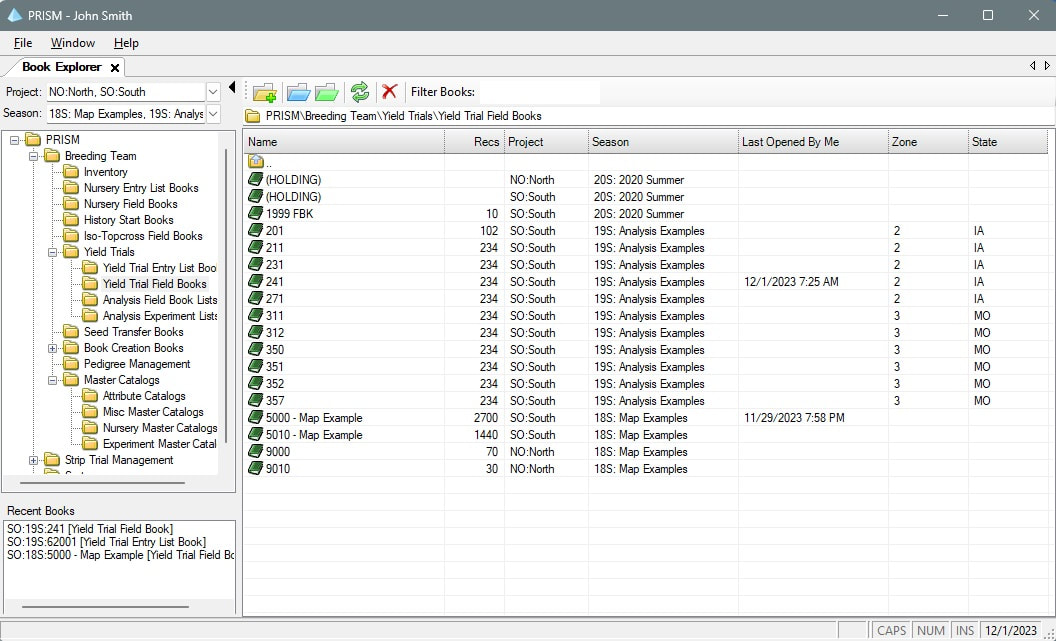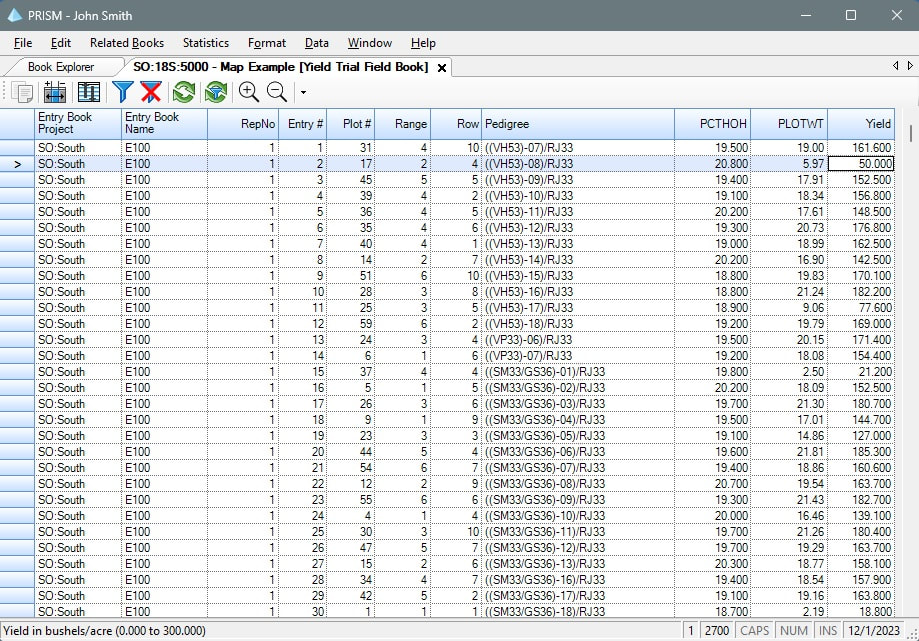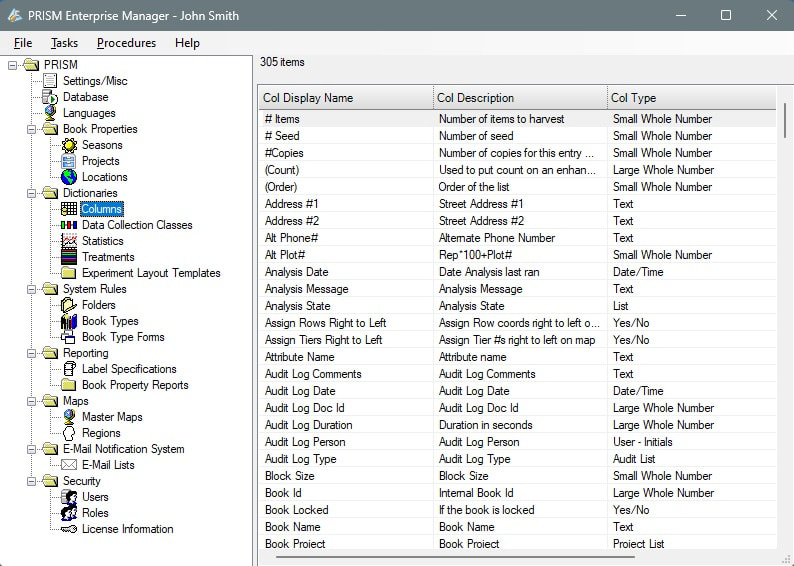PRISM Overview
PRISM is an integrated software solution for plant researchers and agronomists. It was designed from the beginning to allow data sharing from a central database among researchers at the same or different locations. PRISM is deployed in some organizations supporting more than 600 users in a centralized system with millions of records.
PRISM provides you with user-friendly tools to manage your data. The database is hidden so that knowledge of the database is not required. PRISM consists of several different book types. An example of a book type is an Experiment (Yield Trial) Field Book. Each book type is used to classify information and to execute business rules. PRISM provides tools both to configure the book types and to create additional book types. This tool, the PRISM Enterprise Manager, is described later in this section.
Many of the book types are configured to produce a spreadsheet-like interface. For example, you may create several Experiment Field Books that represent physical fields where experiments are planted. These books are used to record and view information. Data can be entered into the books using the spreadsheet-like interface, data can be imported from Microsoft Excel files, or data can be easily copied/moved from other books using drag and drop.
PRISM has a special import feature called Merge. Merge is used to take data collected from an outside source such as a hand-held data computer and save it into the PRISM database. For example you may take a hand-held device out to the field and record plant height for some or all the plots in your field. You can then take the file from the hand-held computer and update the plant height column in your field book for each plot. Merge is used extensively during harvest to take data collected by the combine and place it into the PRISM database for analysis. An Interactive Merge feature is also provided that allows you to interface with devices such as bar-code readers and scales.
You can create and print your own reports and labels (including barcodes). Search criteria can be built to allow you to query certain records. Searching, as well as printing report and labels, can be done across books - this allows you to search or produce reports that span different books and go across years if desired
PRISM provides you with user-friendly tools to manage your data. The database is hidden so that knowledge of the database is not required. PRISM consists of several different book types. An example of a book type is an Experiment (Yield Trial) Field Book. Each book type is used to classify information and to execute business rules. PRISM provides tools both to configure the book types and to create additional book types. This tool, the PRISM Enterprise Manager, is described later in this section.
Many of the book types are configured to produce a spreadsheet-like interface. For example, you may create several Experiment Field Books that represent physical fields where experiments are planted. These books are used to record and view information. Data can be entered into the books using the spreadsheet-like interface, data can be imported from Microsoft Excel files, or data can be easily copied/moved from other books using drag and drop.
PRISM has a special import feature called Merge. Merge is used to take data collected from an outside source such as a hand-held data computer and save it into the PRISM database. For example you may take a hand-held device out to the field and record plant height for some or all the plots in your field. You can then take the file from the hand-held computer and update the plant height column in your field book for each plot. Merge is used extensively during harvest to take data collected by the combine and place it into the PRISM database for analysis. An Interactive Merge feature is also provided that allows you to interface with devices such as bar-code readers and scales.
You can create and print your own reports and labels (including barcodes). Search criteria can be built to allow you to query certain records. Searching, as well as printing report and labels, can be done across books - this allows you to search or produce reports that span different books and go across years if desired
|
The PRISM Book Explorer is shown below:
General Book Features
The following features are found in most of the books in PRISM (this is a partial list)
A sample book is shown below:
- Use the Excel-like interface to add or edit records
- Change/sort the order records are viewed. Unlike Excel, PRISM will not mismatch data if you don't select properly before sorting
- Import Microsoft® Excel worksheets or CSV (comma separated values) files
- Export books to Microsoft® Excel worksheets or CSV files
- Merge data into your books from a Microsoft® Excel or CSV files
- Interactively merge using bar-code readers and laboratory devices such as scales
- Build and save search criteria to filter records
- Print books
- Build and print your own reports and labels including bar-codes
- Record who printed the labels and when they were printed
- Send label output to a file for interfacing with packet printers such as the Freehand® printer
- Create reports that will summarize or group information
- Use Drag and Drop to easily move information between or within books
- Assign a series/sequence to a group of records
- Save and retrieve images and files
- Add new columns to books
- Change the book appearance such as fonts, colors, column size, etc.
- Save and retrieve your common column layouts
A sample book is shown below:
PRISM Enterprise Manager
The PRISM Enterprise Manager Tool allows you or a system administrator to define what data is tracked in the system, valid values/ranges for the data, and what types of access users have to the data. The PRISM Enterprise Manger allows you to define the terminology and standards of tracking data so that data collection is consistent across your organization and from year to year. If you data needs change over time, the PRISM Enterprise Manager can accommodate those changes.
You can customize the columns in all the book types. PRISM allows you to create new columns, such as Plant Height, for books. You can restrict column creation to only certain users to help maintain data integrity. You can also give users limited access to columns within the books or limited features within a book (such as not allowing them to delete records) if desired.
You can provide much of the customization through the PRISM Enterprise Manager. For example you can add columns to the books, define the type and validation rules behind the columns, create columns that use functions, rename existing columns, etc. You can also create and design data entry forms to be used within PRISM.
This tool also allows you to manage security by giving you the ability to create and manage roles for assigning permissions such as: the ability to add new columns, what book types they have access to, what columns they can view, what columns they can edit, what projects they have access to, where they can delete records, where they can edit records, etc. This is discussed more in the Technical Information section.
A sample screen from the Enterprise Manager is show below:
You can customize the columns in all the book types. PRISM allows you to create new columns, such as Plant Height, for books. You can restrict column creation to only certain users to help maintain data integrity. You can also give users limited access to columns within the books or limited features within a book (such as not allowing them to delete records) if desired.
You can provide much of the customization through the PRISM Enterprise Manager. For example you can add columns to the books, define the type and validation rules behind the columns, create columns that use functions, rename existing columns, etc. You can also create and design data entry forms to be used within PRISM.
This tool also allows you to manage security by giving you the ability to create and manage roles for assigning permissions such as: the ability to add new columns, what book types they have access to, what columns they can view, what columns they can edit, what projects they have access to, where they can delete records, where they can edit records, etc. This is discussed more in the Technical Information section.
A sample screen from the Enterprise Manager is show below:
PRISM Framework and Custom Solutions
PRISM provides a solid framework for organizing your data. The PRISM Enterprise Manager can be used to configure and build upon this framework. In the plant breeding and experiment systems, PRISM is pre-configured with several book types such as Inventory Books, Nursery Field Books, Experiment Entry List Books, and Experiment Field Books. You can create additional book types within the PRISM Enterprise Manager.
Some examples of book types that have been created for or by PRISM customers are:
Some examples of book types that have been created for or by PRISM customers are:
- Lab Books to track lab and sampling data
- Transgenetic systems including Construct Tracking, DNA Donor and Delivery, Event Creation, and Plant Creation.
- Permit and Regulatory Tracking
- Cooperator Books to track cooperators that participate in experiments
- Seed Invoicing, Seed Transfer, and Seed Requests books.
Inventory Books
Many systems are pre-configured with an Inventory Book Type (sometimes called a Cold Storage Book). Its primary goal is to keep track of the seed in your inventory and to provide a central point for building other books such as field books and experiments.
Although PRISM allows you to define the information you wish to track, Inventory books typically contain source, pedigree (or hybrid/variety), quantity, and inventory location. Shown below is a typical Inventory book:
In addition to the standard import feature, pedigrees can be brought into other books by dragging and dropping from the Inventory books. As fields are harvested new inventory/pedigrees can be generated and brought back into Inventory. This is described in more detail in the Nursery Management section. PRISM allows you to specify the quantity used in each of the field books (and other books) which automatically updates the quantity in Inventory.
Although PRISM allows you to define the information you wish to track, Inventory books typically contain source, pedigree (or hybrid/variety), quantity, and inventory location. Shown below is a typical Inventory book:
In addition to the standard import feature, pedigrees can be brought into other books by dragging and dropping from the Inventory books. As fields are harvested new inventory/pedigrees can be generated and brought back into Inventory. This is described in more detail in the Nursery Management section. PRISM allows you to specify the quantity used in each of the field books (and other books) which automatically updates the quantity in Inventory.




